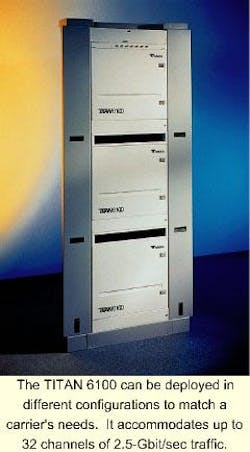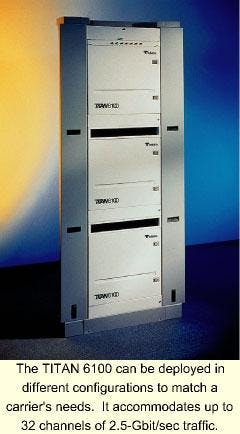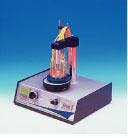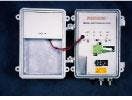Fiber Products and Technology
In an effort to offer service providers a more flexible optical-networking system that also reduces capital costs, Tellabs has introduced the TITAN 6100 optical-transport system. The new product, designed specifically for high-speed metropolitan service applications, is the first in Tellabs' 6000 series of global optical-networking systems.
Using DWDM technology, the TITAN 6100 system carries 32 wavelengths of data, voice, and video traffic over a single fiber-optic pair, offering service providers expanded bandwidth without the need for additional fiber. The system is designed to provide a platform that will grow in multiple dimensions-capacity, increased distance, and simplified operations, administration, maintenance, and provisioning. Capacity can be expanded by both the number of channels and line rate per channel.Perhaps an equally attractive feature of the system is its ability to support mesh, ring, and point-to-point architectures from the same platform. That means TITAN 6100 systems initially deployed for point-to-point applications can "grow with the network." Systems can be interconnected without transponders, enabling optical pass-through of traffic not intended for local termination. The elimination of additional transponders can significantly reduce network costs. Additionally, the systems can be connected while in service, without affecting the operation of other channels already deployed within the network.
According to Tellabs, competitors must use back-to-back terminals linked by transponders to deliver the same mesh pass-through capabilities. Alternatively, they have to use add/drop multiplexers that can only support ring configurations. This method requires more complex planning with separate platforms.
Philip Richards, vice president and chief analyst at New Jersey-based Insight Research Corp., says the TITAN 6100 will eventually have a lot of potential in the marketplace. The adding/dropping of dark wavelengths in metropolitan areas is something customers would be interested in.
"For instance, there's a brokerage firm in Manhattan that has its back office in New Jersey," says Richards. "They don't want anybody mucking around with their channel to that back office. Some of them have actually installed their own fiber to achieve that. But you can provide the equivalent by selling a dedicated wavelength to them. Also, it allows you to use fiber quite effectively."
The TITAN 6100 can be deployed in several different configurations. For example, a 32-channel optical-line terminal would consist of one shelf of common equipment and up to two shelves of port interfaces. It can grow in service from one channel to 32 channels of 2.5 Gbits/sec each. Configured as a 32-channel optical add/drop multiplexer, two optical-line terminals can be connected to allow add/drop of a varying number of channels. Changing any channel from an add/drop channel to a pass-through channel does not affect the other channels.
"One advantage of this particular product is that wavelengths don't have to be converted to the electronic level unless you intend to add or drop them," says Richards. "The rest of them just continue through on the optical level. You can save a good bit of equipment by not having to deal with that."
The TITAN 6100 also provides management capabilities through its element-management system that gives multiple users simultaneous management access to multiple systems. The PC-based Craft Station provides a single user with portable tools to install and maintain a TITAN 6100 system through a graphical user interface. The TITAN 6100 Lightpath Manager is a circuit-management tool that enables end-to-end bandwidth management at the DWDM optical-channel layer across multiple systems.
Tellabs plans to begin lab trials of its TITAN 6100 system in the third quarter of 1999, with controlled introduction beginning in the fourth quarter of 1999. Once controlled introduction criteria have been completed, general availability will be announced. The initial release of the system will feature Synchronous Optical Network and Synchronous Digital Hierarchy interfaces supporting speeds up to 2.5 Gbits/sec, including OC-3/STM-1 (155 Mbits/sec), OC-12/STM-4 (622 Mbits/sec) and OC-48/STM-16 (2.5 Gbits/sec).The Series 4000 L-band fiber-optic link is designed for cable-TV headend applications. It is based on the sat-light L-Band platform and is comprised of a weatherized transmitter outdoor unit and a 1U rack-mounted indoor unit (IDU). The system transmits both horizontal and vertical polarities over a single fiber from the antenna to the headend. At the headend, the IDU provides an 8-way output of -20 dBm per port and can be fully integrated into existing splitter networks. It can transmit up to 5 km over a singlemode fiber. Foxcom Inc., Princeton, NJ




